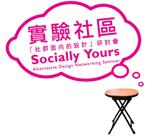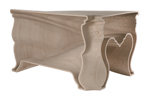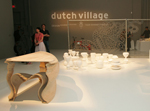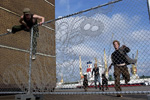
|
Day One: Design and Alternative Process Jeroen Verhoeven Presentation In the presentation Jeroen Verhoeven introduced some of the products of DEMAKERSVAN. Industrial production is for them a big source of inspiration. Their projects often show their concern of bringing the exploring the forms of industrial product, pushing industrial product into another level. Many of the products that Verhoeven presented showed the tendency of questioning the standardized industrial products through exploring their forms. Take the Cinderella table for instance. They used a high-tech method as our new modern “craft’. Sketches of old furniture were put into a computer that translated them into a drawing that could only exist in a digital world. Cinderella is about attention and the possibility to make something unique with a machine that is normally used for mass production. DEMAKERSVAN often combine the sensitive and the small with the powerful, larger and industrial. Like the Lace Fence project “How to Plant a Fence” that translates this line of thinking. They think that fencing is a sign how we modified and cultivated our environment. Through fences different individuals in the society are excluded in different levels. But what would happen if a patch of embroiled wire would meet with and continue as an industrial fence. DEMAKERSVAN worked on this exciting idea since they had this. The result is just as fascinating as it gets; in the fence, we see hostility versus kindness and industrial versus craft. The Lacefence also shows that something purely functional could be decorative. Many of their innovative twist on industrial products are underpinned by substantial research on original or traditional production method. Like for the Lace Fence, Lace is one of the major tradition products of Netherlands, DEMAKERSVAN spent much time on studying the embroidery technique. They have also done research on the similarity between this technique and fence wiring. Verhoeven emphasized their rejection of the throwaway nature and sameness in modern production; they want to retrieve that uniqueness that once existed among our things. At the same time, they also try to balance the practice with possible industrial manufacture, so as to make the products available to the public.
Biography Twin brothers Joep and Jeroen Verhoeven and Judith de Graauw met at the Design Academy in Eindhoven and formed the design team Studio DEMAKERSVAN (“The Makers of…”). The team compare themselves to an orchestra. Each concept may originate with one maker, but the ideas are developed collectively. Their work caught the attention of the design world, even before they graduated – the industrialized wood table (“Cinderella”), which Jeroen made for his final exam, and a decorative steel fence, “How to Plant a Fence”, his twin brother Joep Verhoeven’s final exam project. Both work were produced with attention to craftsmanship, which, to the team, has been pushed too far to the background in a digital world. The team decided to work in a similar way as the Haute Couture fashion world works, maintaining a labour-intensive and closely controlled process. The Studio is against the throwaway nature and sameness in modern production, but at the same time, balances the practice with industrial manufacture, so as to make the products available to the public. Website: www.demakersvan.com |
| X Close | |




